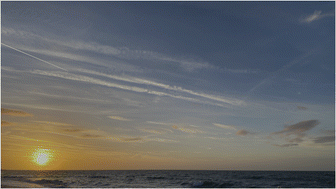Uncertainties in mitigating aviation non-CO2 emissions for climate and air quality using hydrocarbon fuels†
Abstract
The uncertainties over the effects of aviation non-CO2 emissions on climate and air quality are assessed in the context of potential mitigation measures for liquid hydrocarbon fuels. Aviation non-CO2 emissions that affect climate include nitrogen oxides (NOx), aerosol particles (soot and sulphur-based), and water vapour. Water vapour and aerosols have small direct radiative effects but are also involved in the formation of contrails and contrail cirrus, currently, the largest non-CO2 effect on climate. These non-CO2 effects on climate are quantified with low confidence, compared to that of CO2, which is quantified with high confidence. The sign of the NOx radiative effects may change from positive to negative. The effects of soot and sulphur emissions on cloudiness are very poorly understood and studies indicate forcings that range from large negative through to small positive. NOx and soot emissions can be reduced through changes in combustion technology but have tradeoffs with each other and CO2. Soot can also be reduced through reduced aromatic content of fuels. In all cases, there are complex choices to be made because of tradeoffs between species, and CO2. Contrail cirrus and soot aerosol–cloud interactions potentially have opposing signs but are both related to soot emissions (at present) and need to be considered together in mitigation strategies. Because of the uncertainties and tradeoffs involved, it is problematic to recommend definitive courses of action on aviation non-CO2 emissions since they may be of limited effect or have unintended consequences. Aviation's non-CO2 effects on climate are short-term, as opposed to those of CO2, which last millennia. If aviation is to contribute towards restricting anthropogenic surface warming to 1.5 or 2 °C then reduction of emissions of CO2 from fossil fuels remains the top priority. In terms of air quality, the situation is more straightforward with emissions standards being set by the International Civil Aviation Organization for NOx and non-volatile particulate matter (and other minor species), which need to be complied with.

- This article is part of the themed collections: Environmental Science Atmospheres Recent Review Articles and Outstanding Papers 2023 – Environmental Science: Atmospheres


 Please wait while we load your content...
Please wait while we load your content...